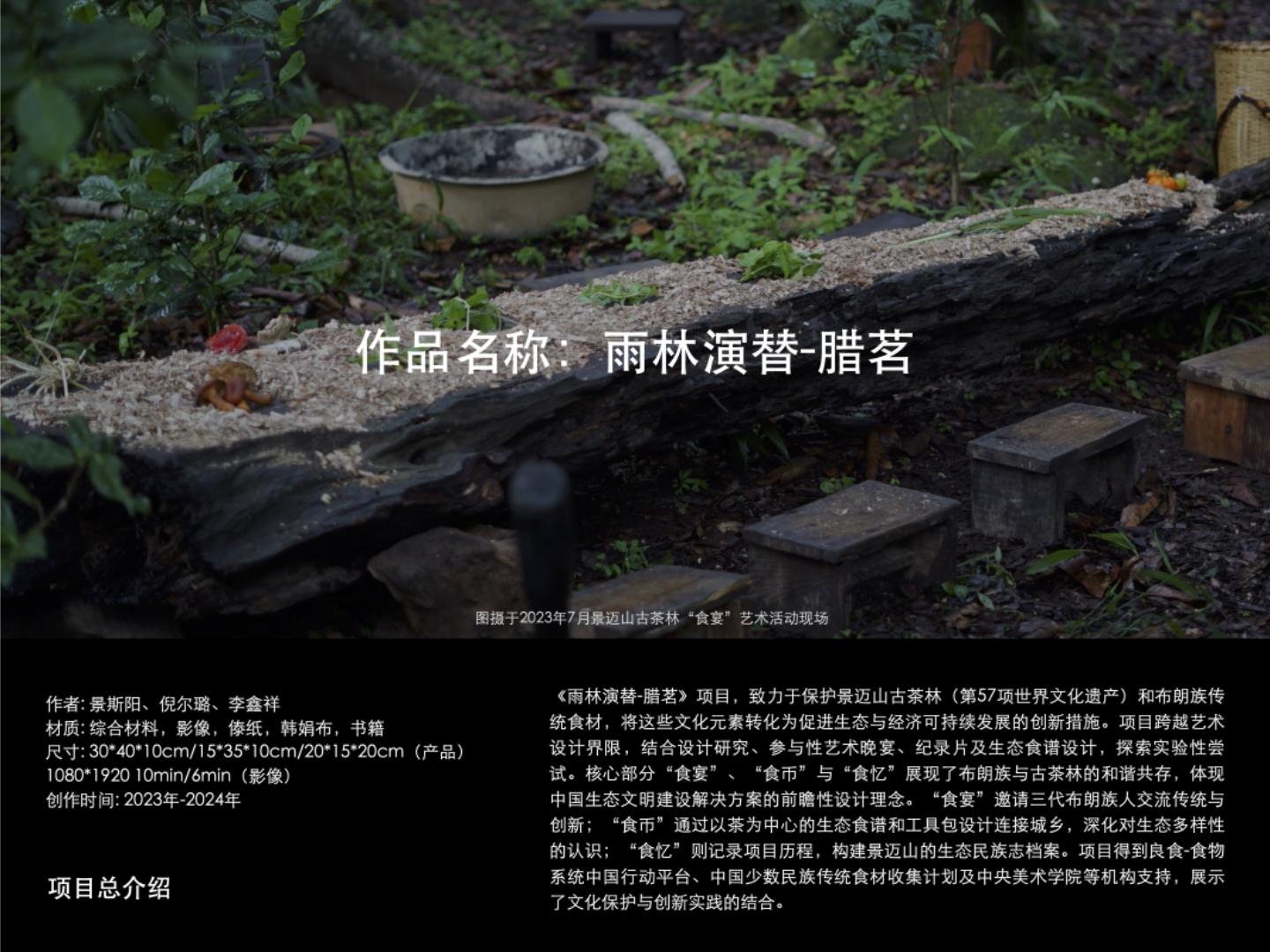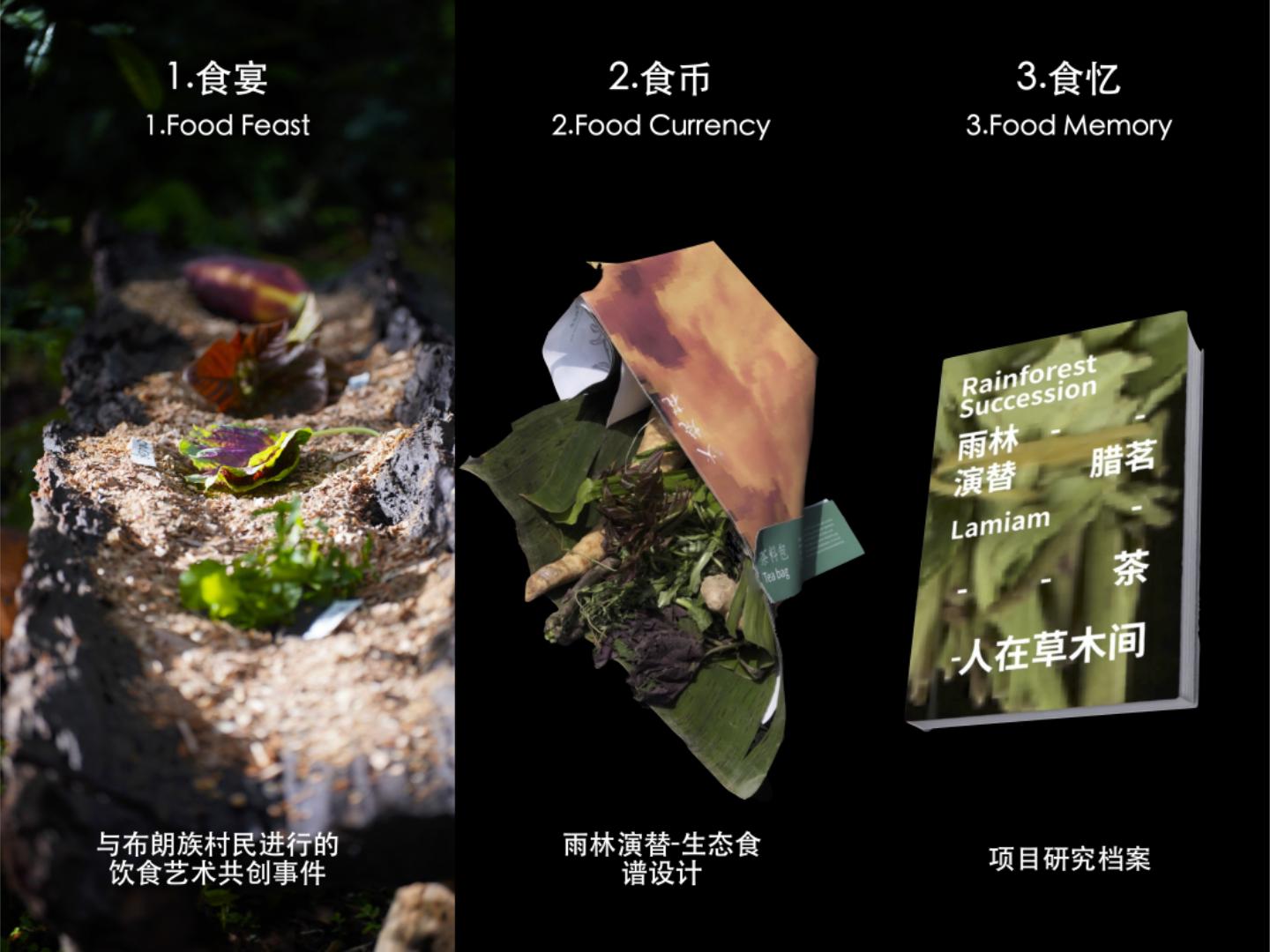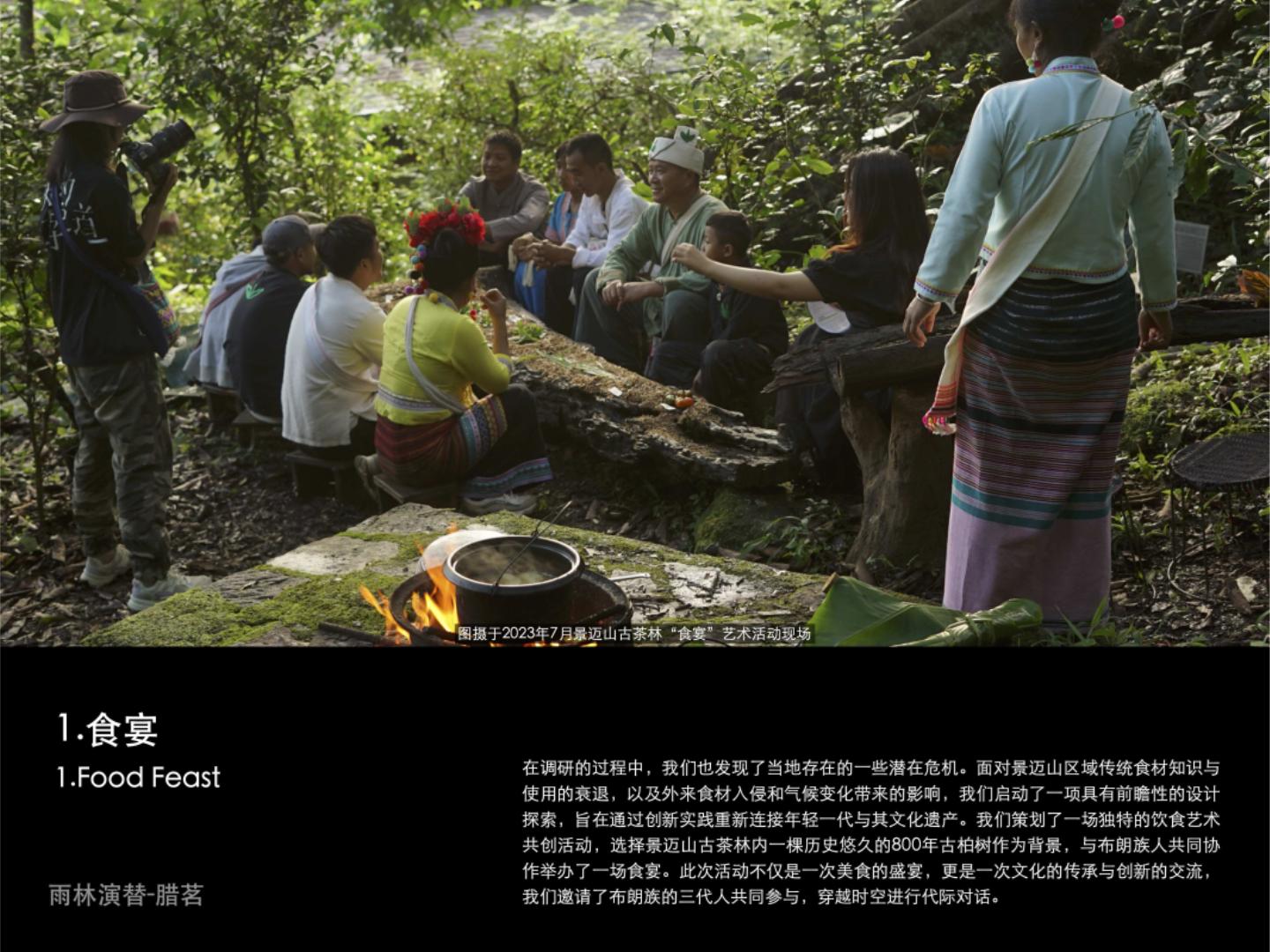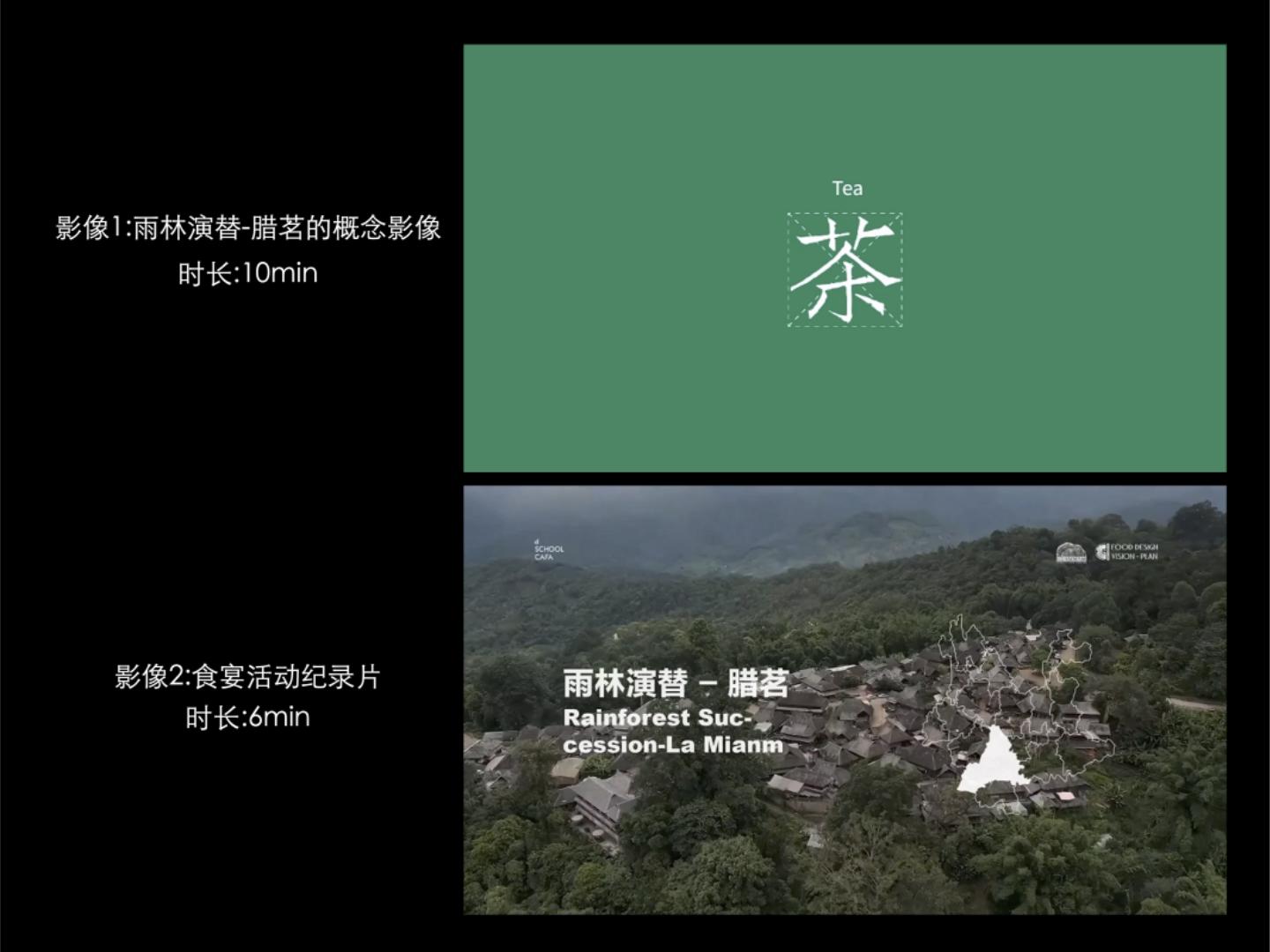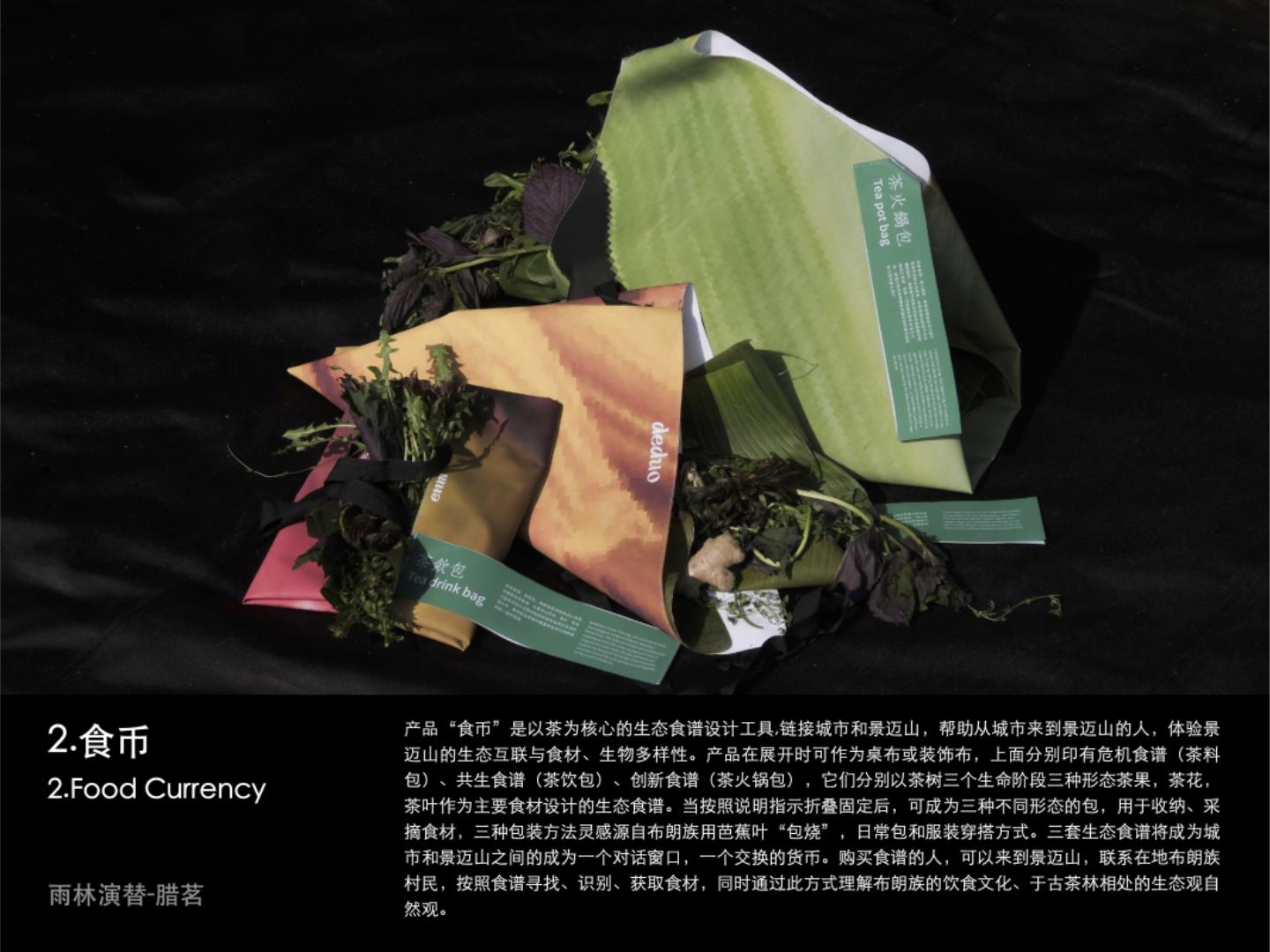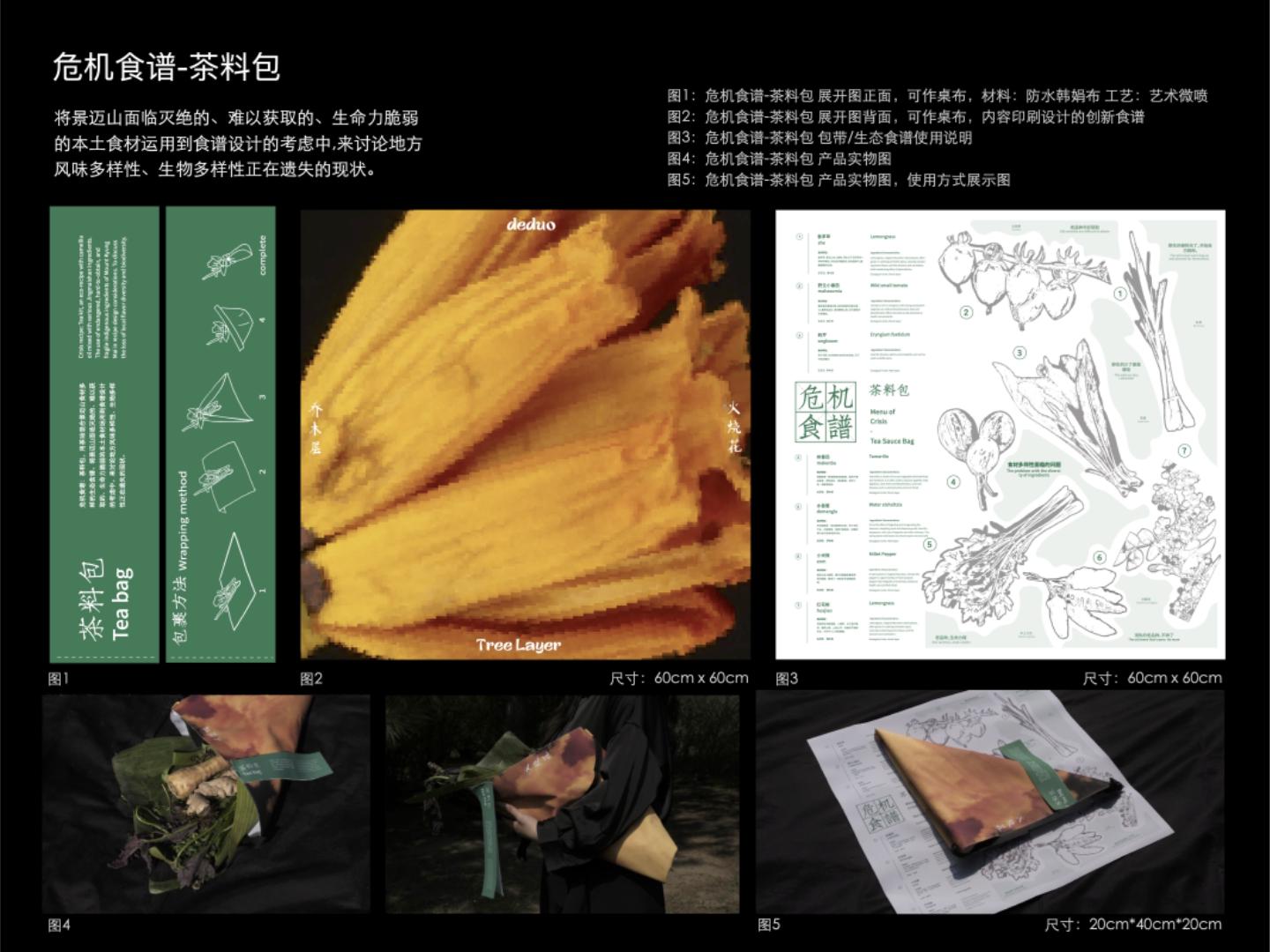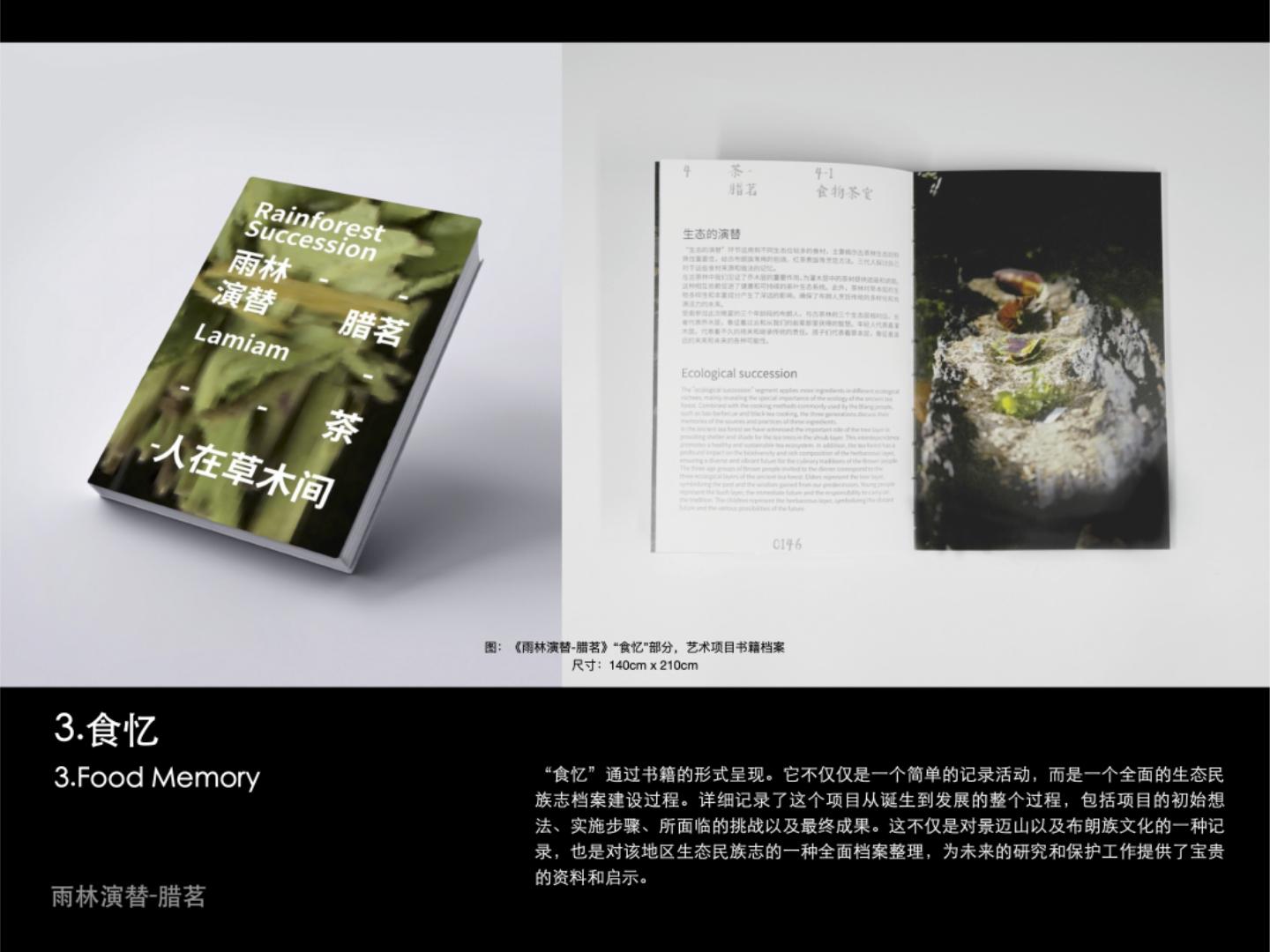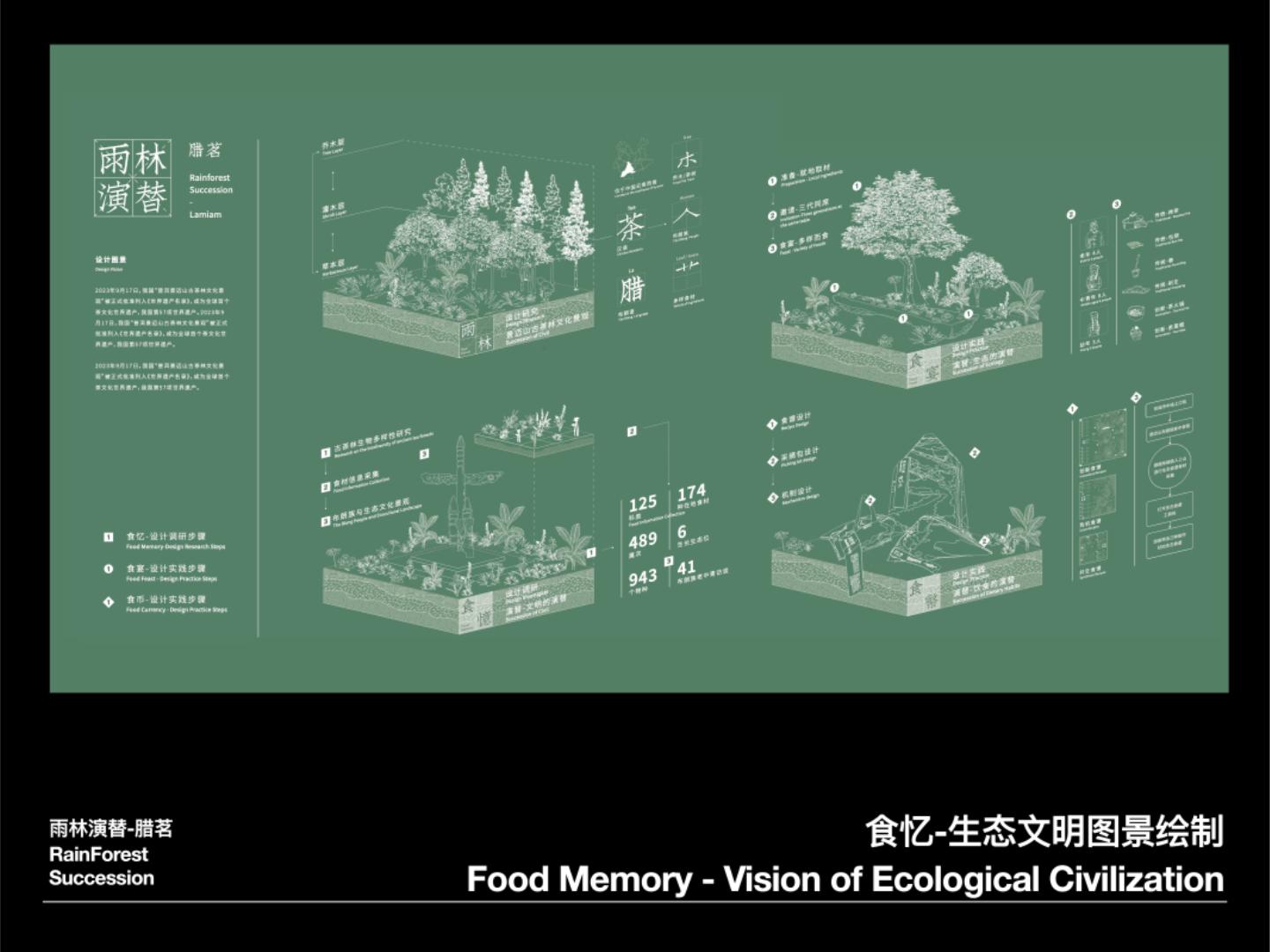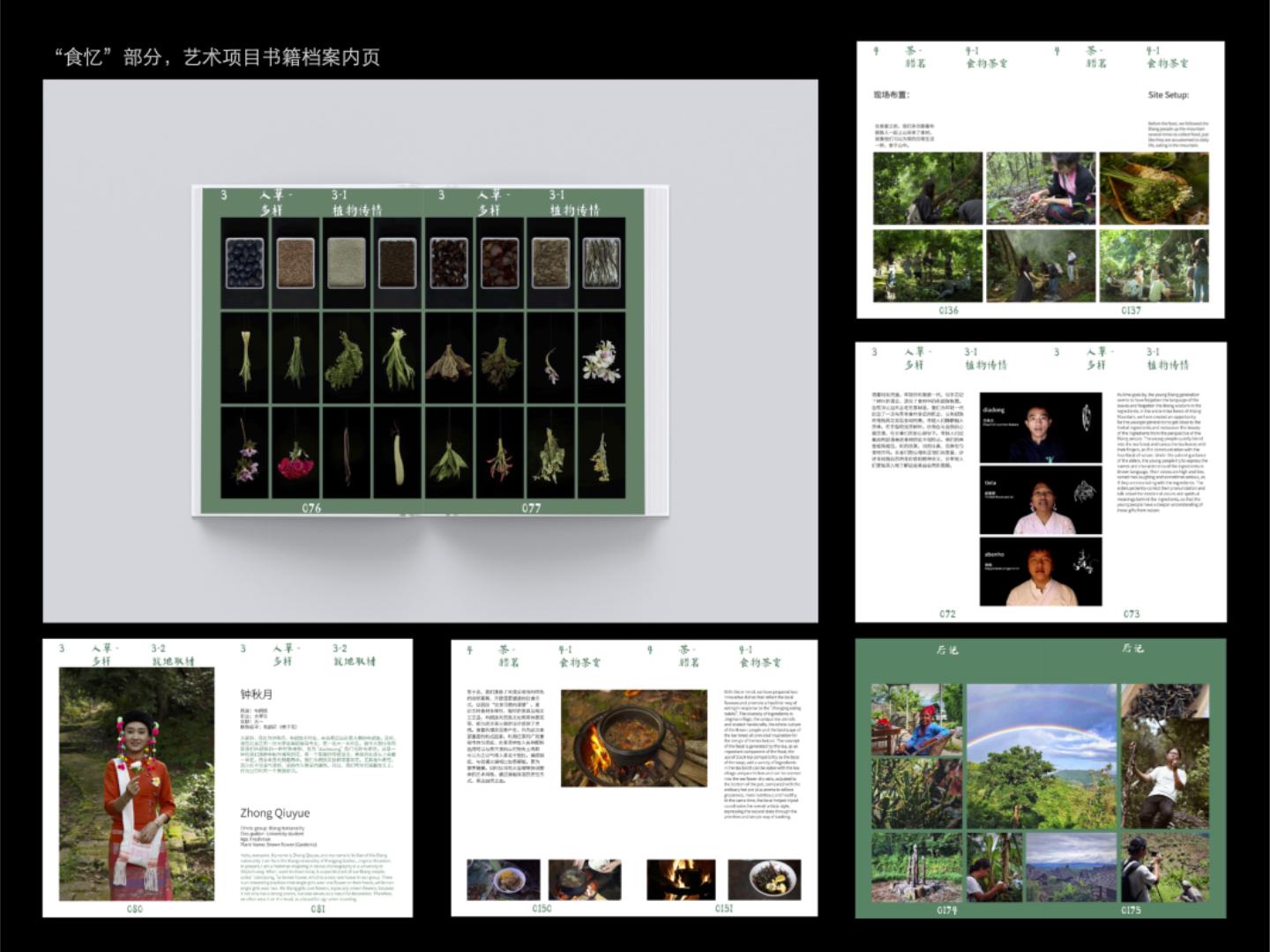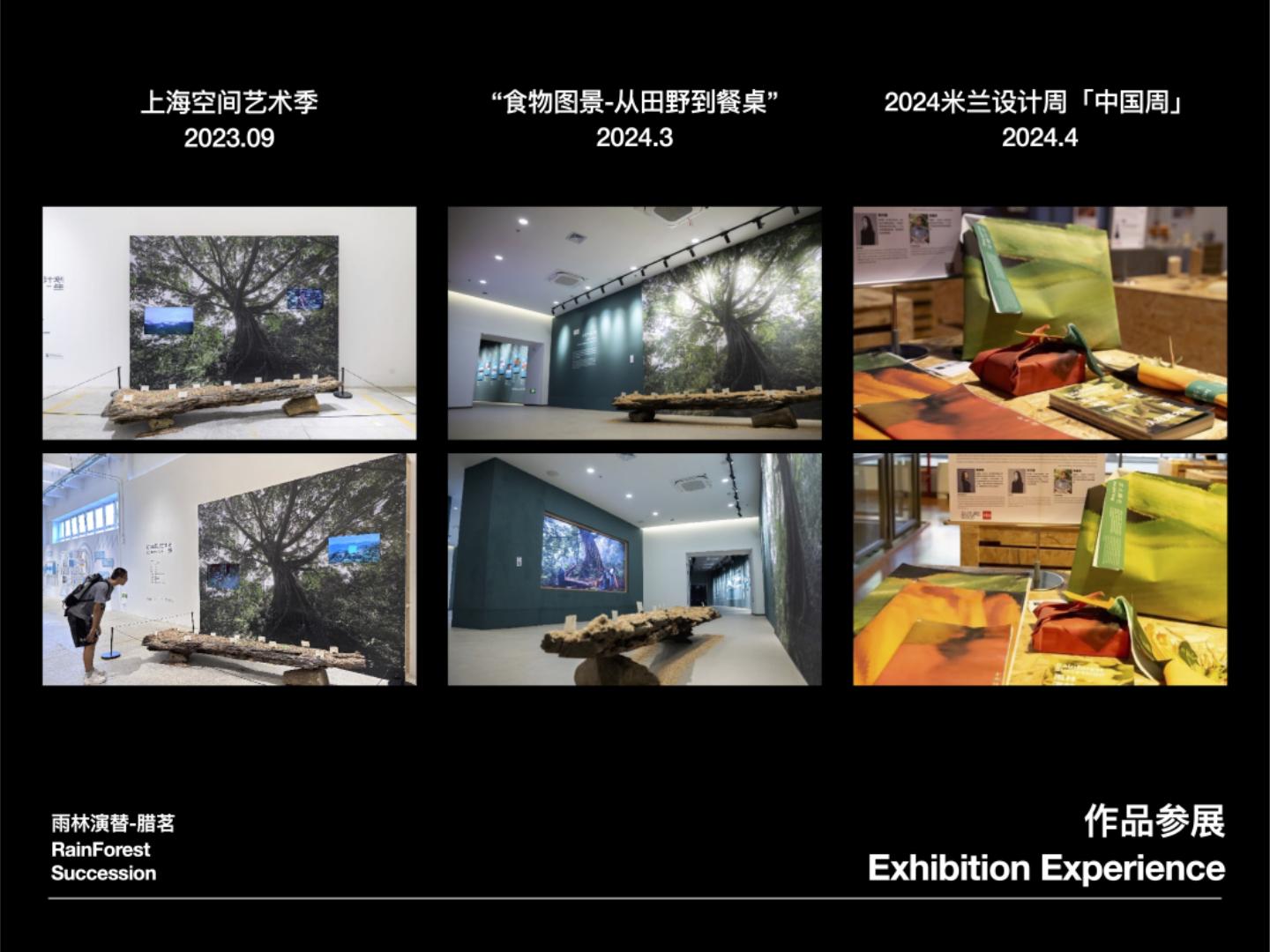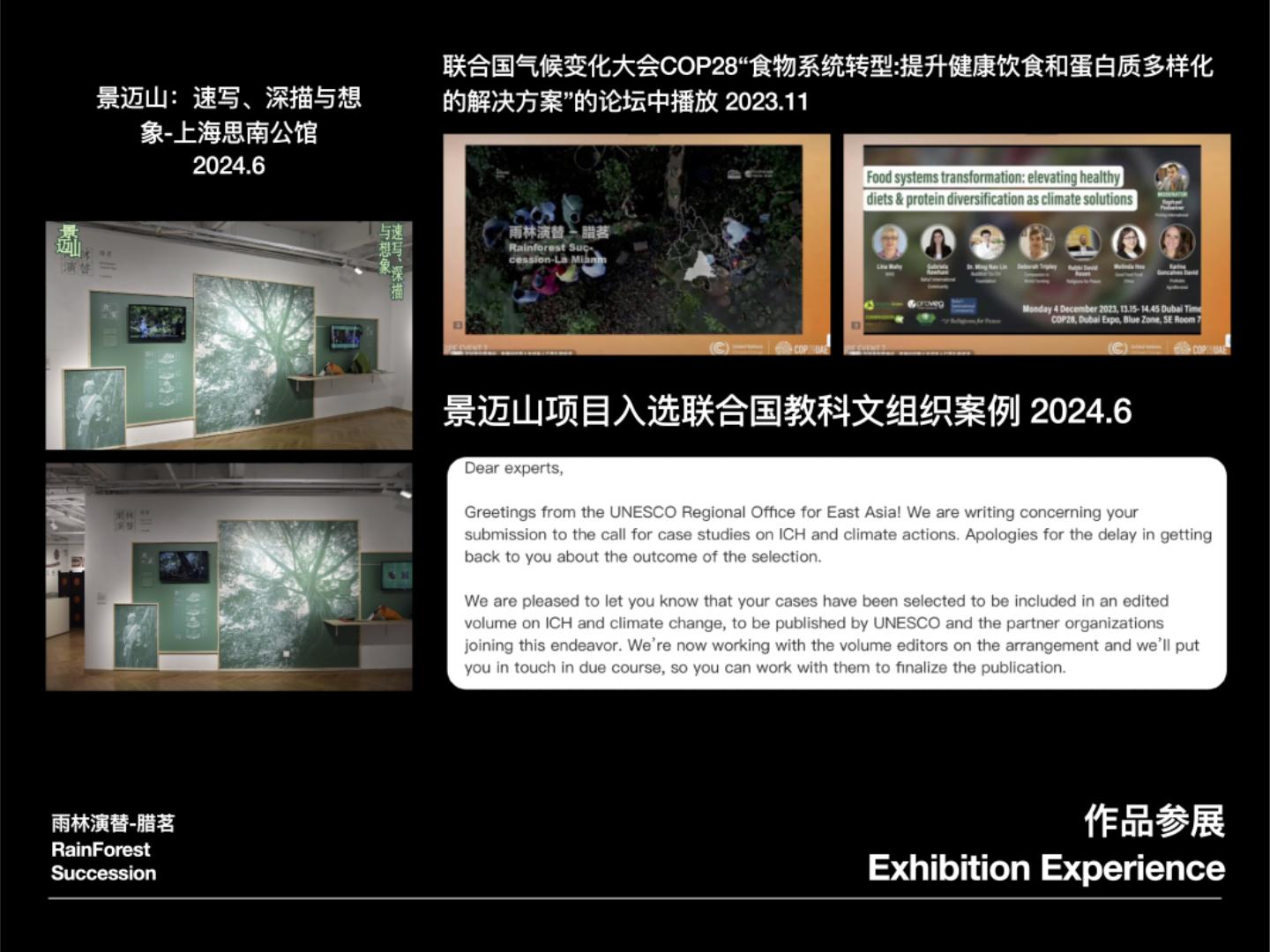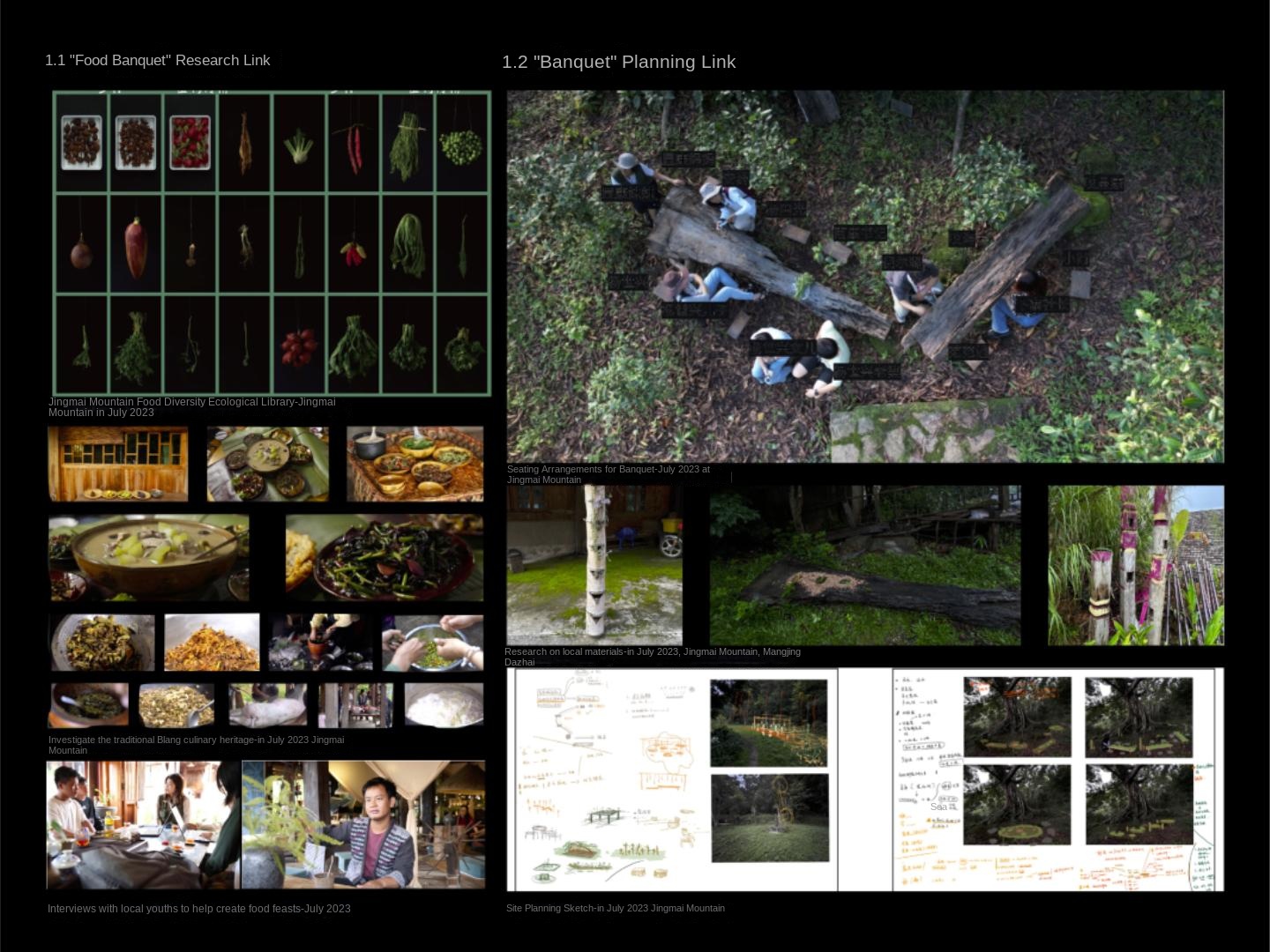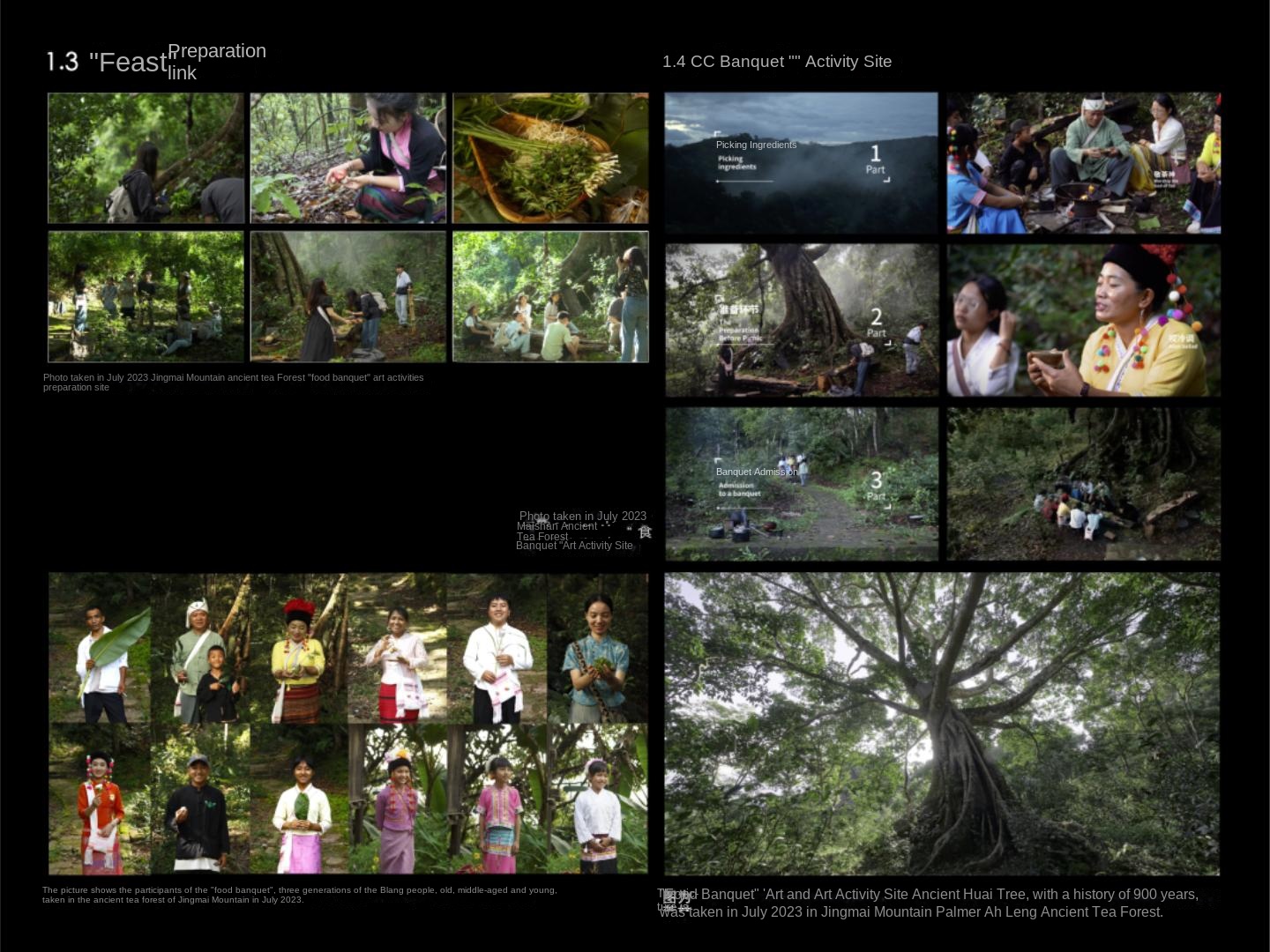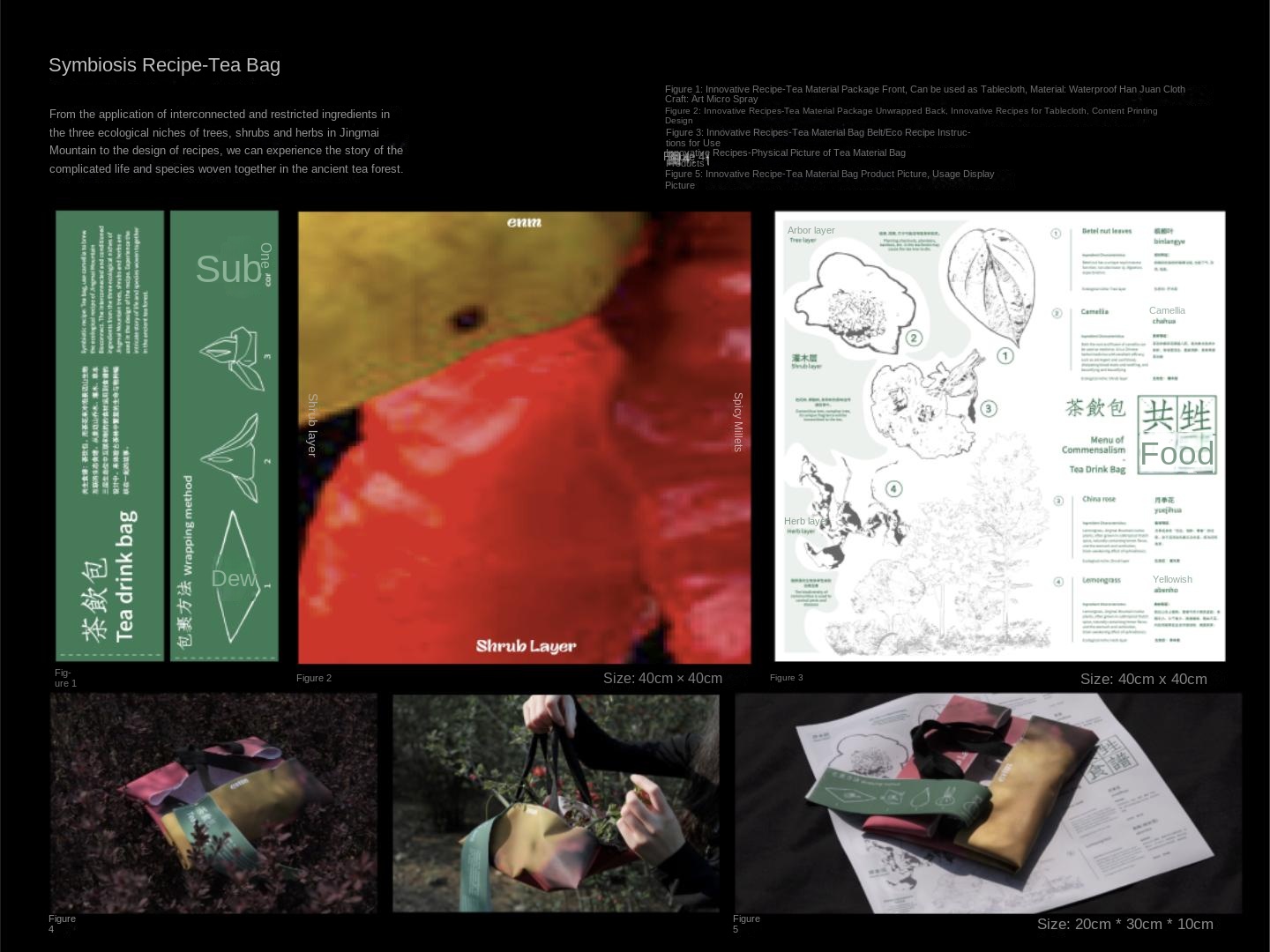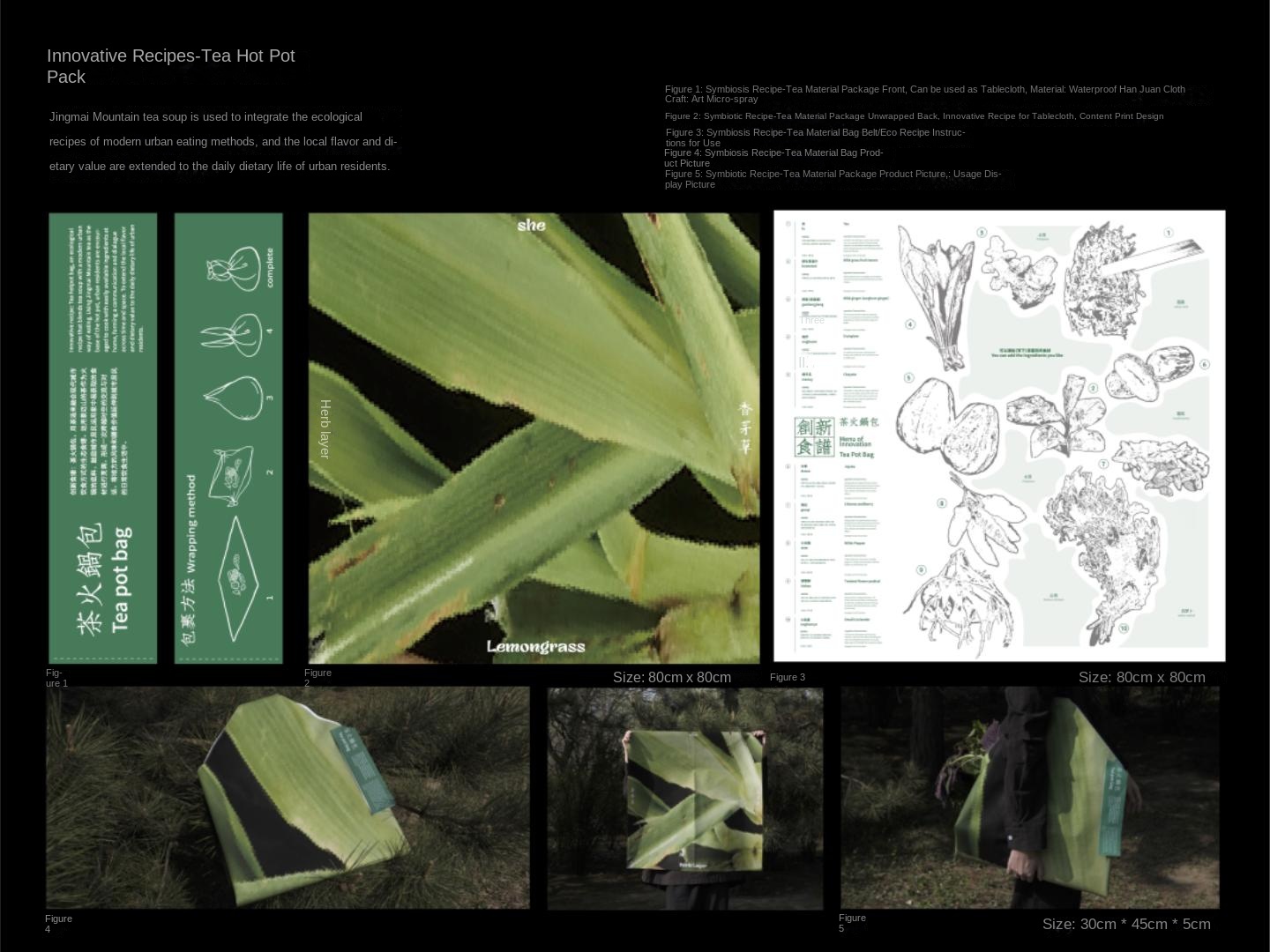Jingmai Mountain Ancient Tea Forest "Food Banquet" Art Activities
"Rainforest Succession-La Ming" Concept Video
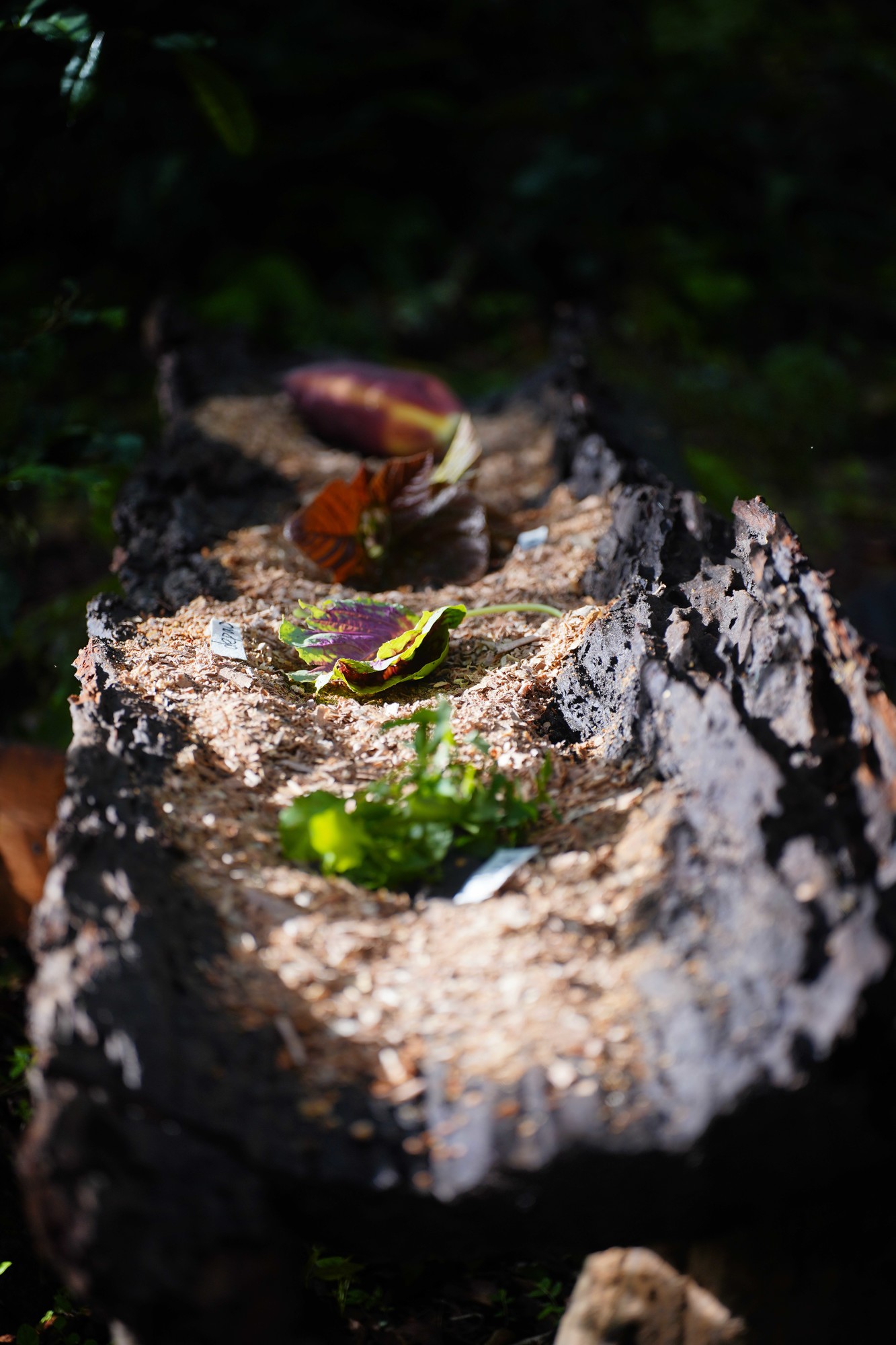
Jingmai Mountain Ancient Tea Forest "Food Banquet" Art Activity Site
An interactive link is designed in the "Food Banquet". By placing the ingredients from different ancient tea forest niches in the correct order and learning their Blang names, the aim is to experience the ingredients from the original perspective and regain the life wisdom of the Blang nationality of "the same source of medicine and food.
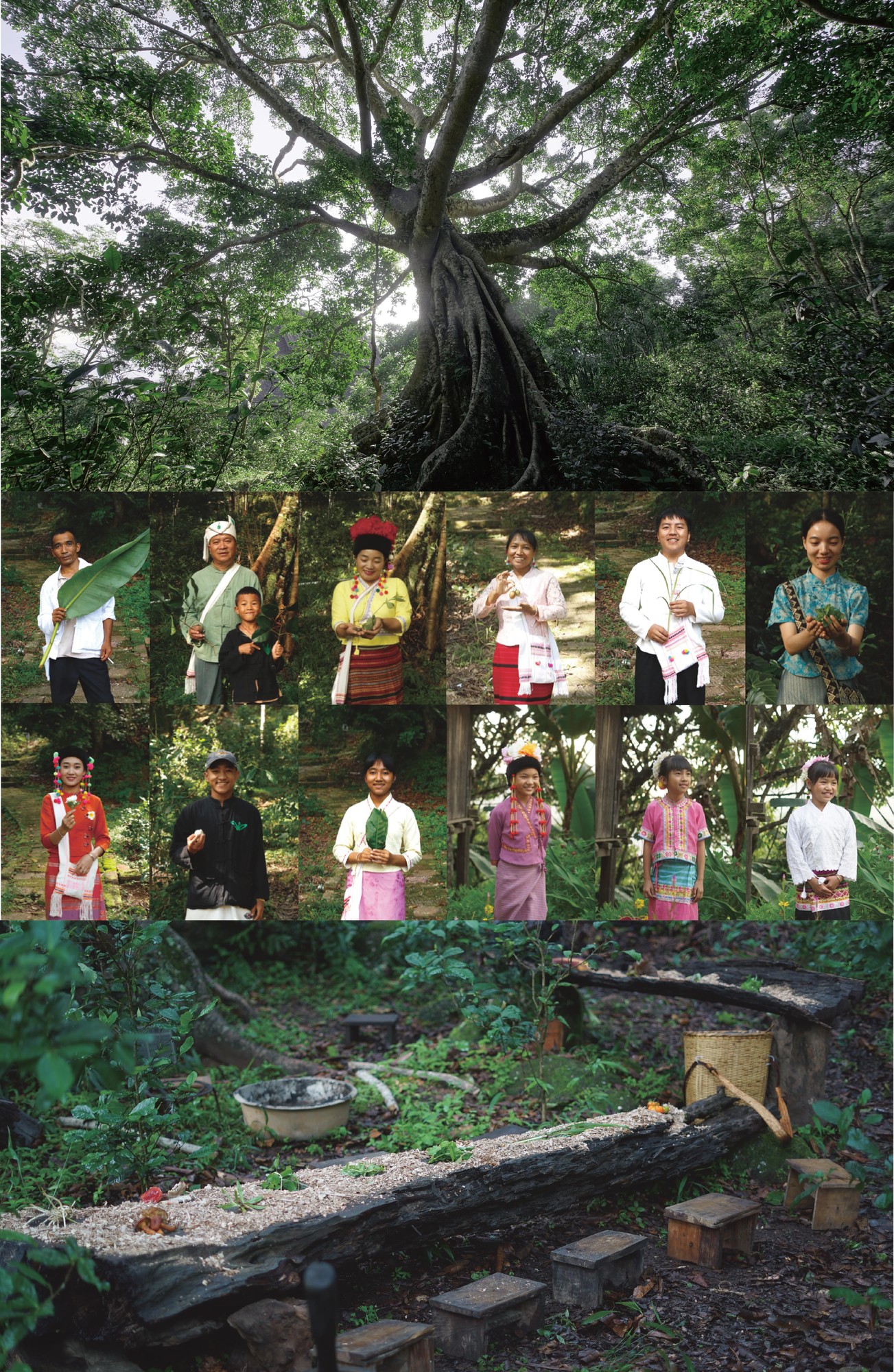
Jingmai Mountain Ancient Tea Forest "Food Banquet" Art Activity Site
In the art co-creation activity, a 800-year-old ancient cypress tree in the ancient tea forest of Jingmai Mountain was selected as the background, and a feast was held in collaboration with the Blang people. The dinner invited three generations of the Bulang ethnic group, old, middle and young.
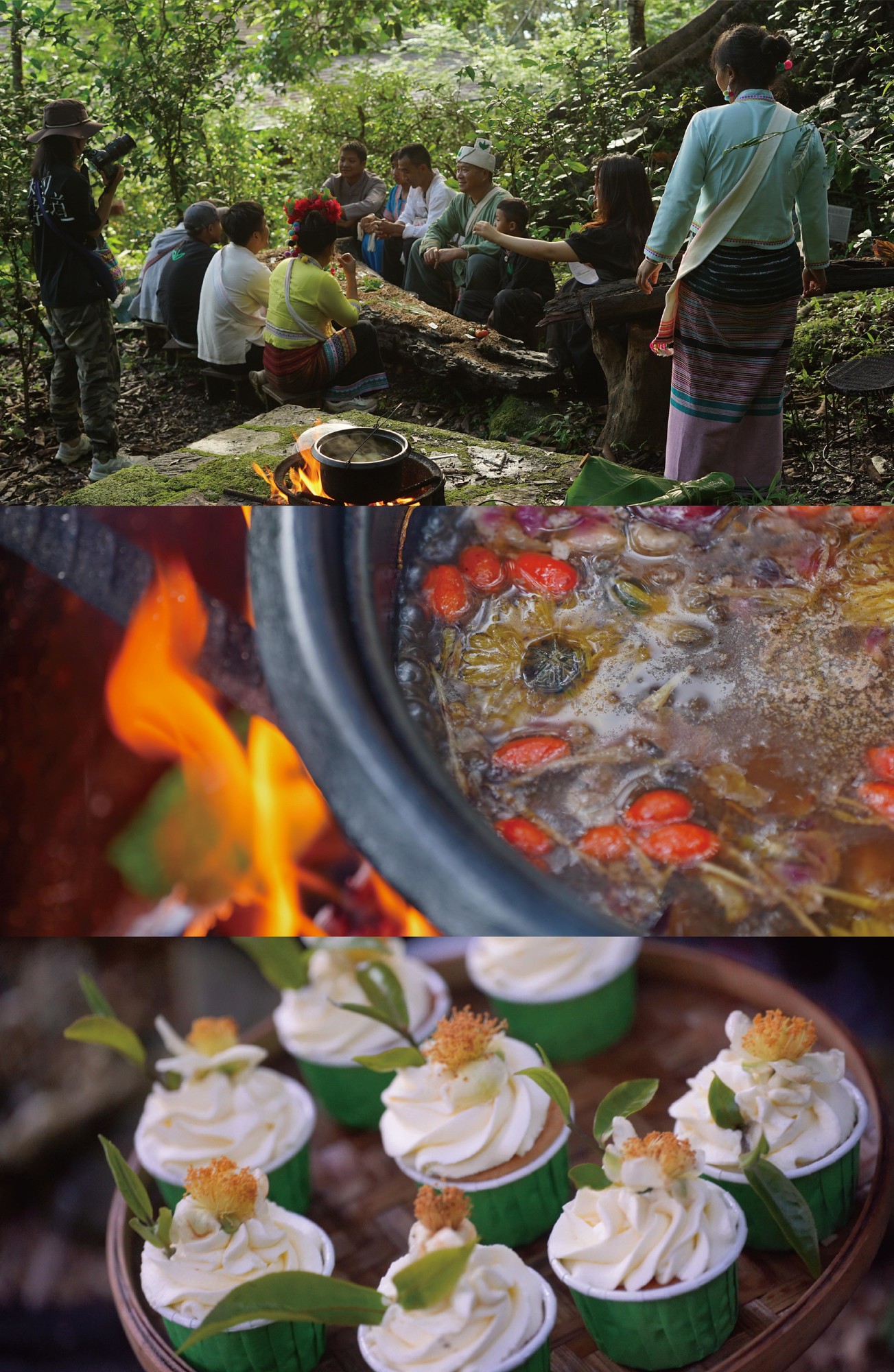
Jingmai Mountain Ancient Tea Forest "Food Banquet" Art Activity Site
Inspired by Jingmaigu's diverse heritage culture, unique ingredients and the Blang tea forest landscape, the cooperation team designed a healthy and flavored tea hot pot with black tea as the soup base, and invited local pastry chefs to create a "tea cake" that combines tea and seasonal ingredients, demonstrating the concept of natural and innovative cuisine.
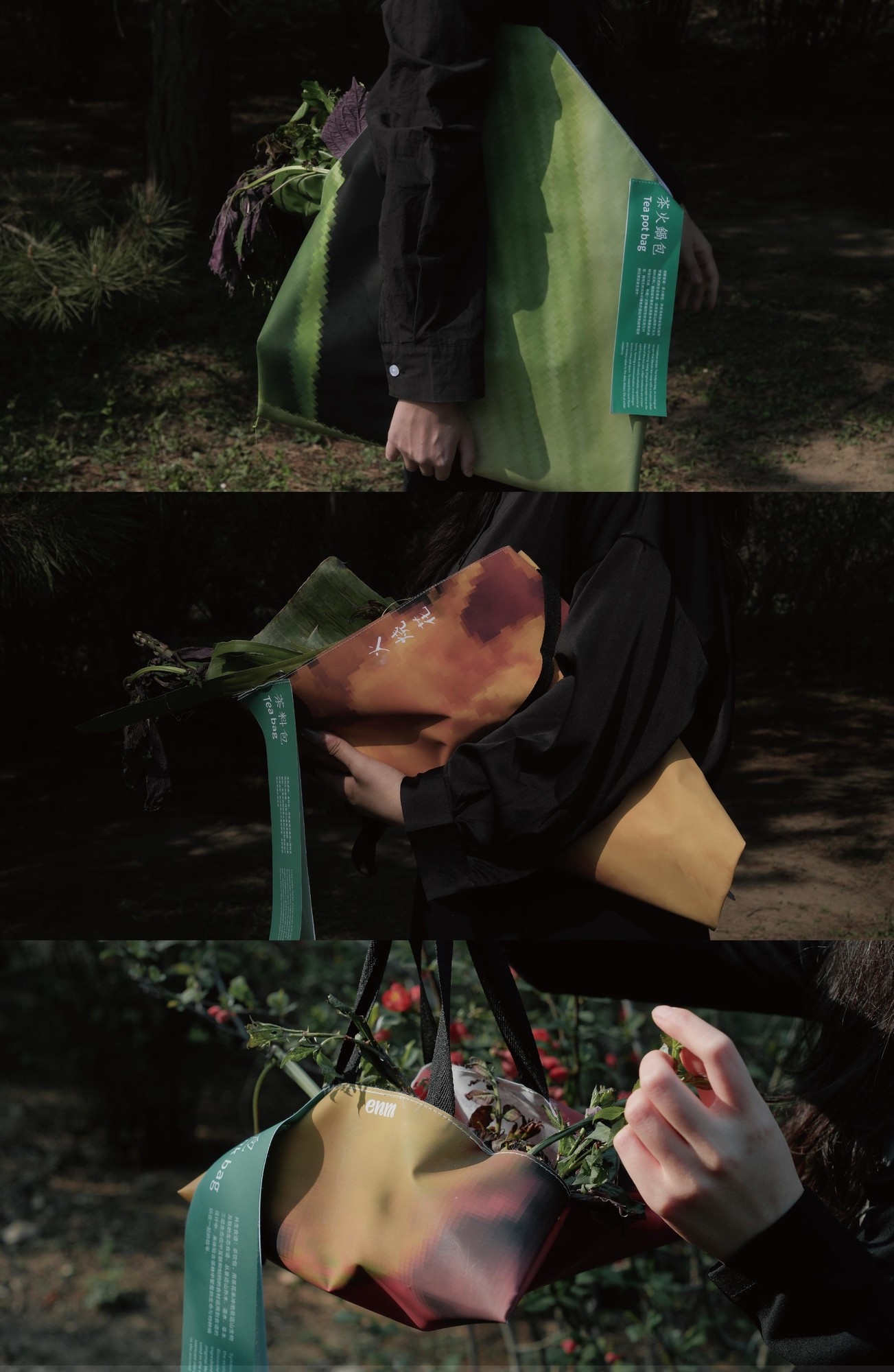
Food Coin-Eco Recipe Design
"Food Coin" is an ecological recipe design tool with tea as the core. It connects the city and Jingmai Mountain through three recipes of crisis, symbiosis and innovation, helping city people experience the ecological interconnection and biodiversity of Jingmai Mountain, and at the same time understand the food culture and natural view of the Blang people. It can be used as a tablecloth, decorative cloth or storage bag, and become a dialogue window and exchange medium between the city and Jingmai Mountain.
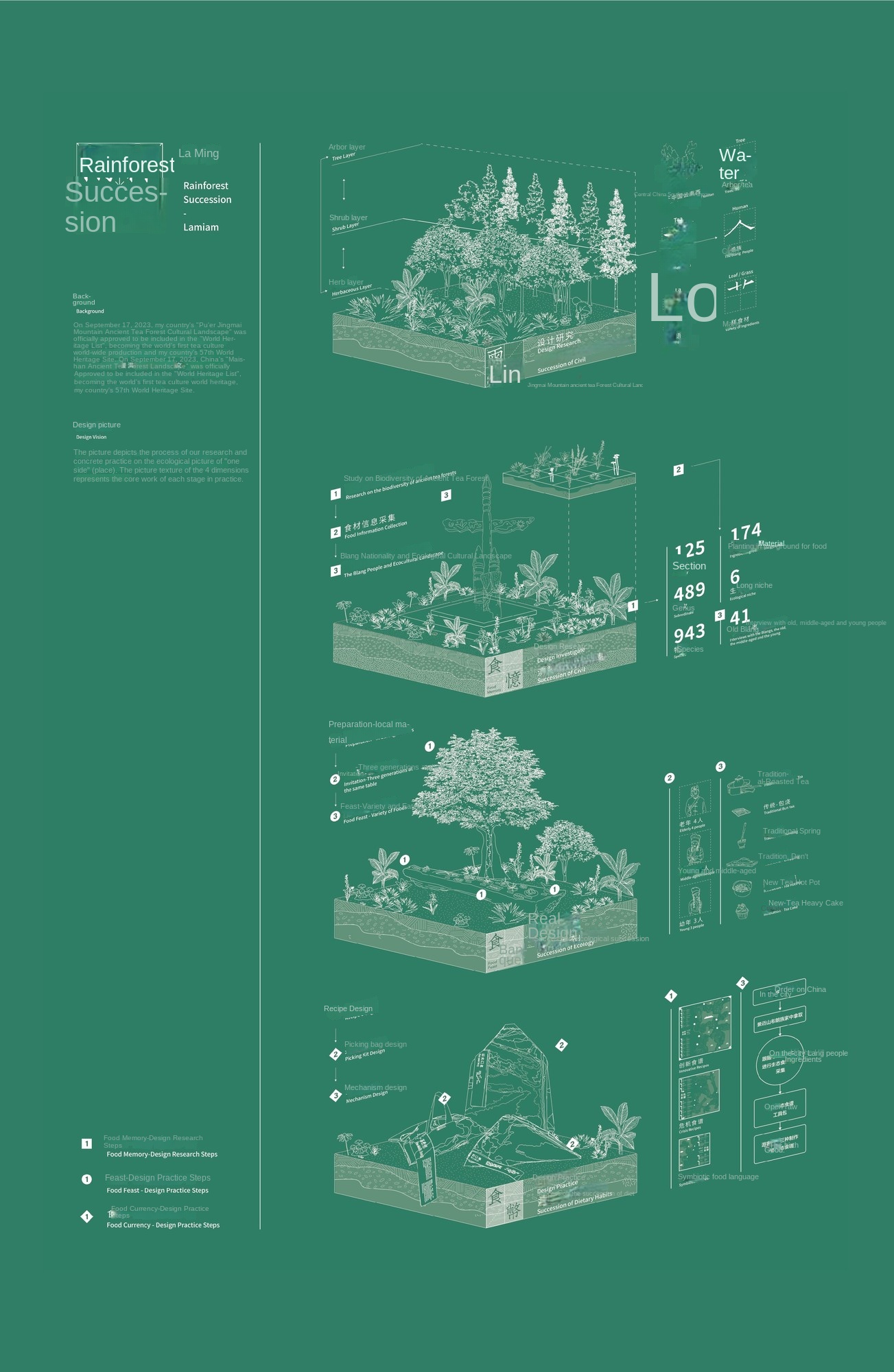
Food Memory-Ecological Civilization Picture
The picture depicts the process of our research and concrete practice on the ecological picture of "one side" (place). The picture texture of the 4 dimensions represents the core work of each stage in practice.
Detailed Work Scheme of Rainforest Succession-La Ming
The document complements the details of the project's research content and practical process, as well as the project's participation experience.
Rainforest Succession-La Ming is a long-term project dedicated to the protection of the biodiversity of the ancient tea forest in Jingmai Mountain and the traditional ingredients of the Blang people. The "under-forest tea planting" model adopted by Jingmai Mountain ancient tea forest is not only a unique rainforest ecosystem in southwest China, but also a deep fusion of Bulang culture and ecological wisdom. However, with the rapid development of tourism and economic modernization, the Jingmai Mountain area is facing the challenge of ecological degradation and biodiversity loss. Through the cross-border integration of art and design, this project combines design research, participatory art dinner, documentary production and ecological recipe design to carry out experimental exploration in many fields. The project mainly includes the following three parts:
Feast:
"Banquet" explores the harmonious coexistence between the Bulang people and the ancient tea forest through intergenerational dialogue and traditional cultural exchanges. Three generations of Blang people are invited to participate, which not only inherits the cooking skills of traditional ingredients, but also promotes the combination of innovation and traditional culture of the younger generation. The food banquet created by the community is not only a feast of taste, but also a platform for intergenerational culture and urban-rural exchanges, showing the unique charm of the interweaving of ecology and culture.
Coin:
"Eating Coin" is an eco-recipe toolkit design with tea as the core, which aims to promote the connection and interaction between urban and rural areas. As a medium of cultural and ecological exchange, food coins help urban consumers connect with Blang villagers by participating in the development of "symbiotic recipes", "crisis recipes" and "innovative recipes. This not only deepens the understanding of ecological diversity of urban and rural residents, but also integrates local characteristic ingredients and culture into modern life, and explores the multi-dimensional dialogue between food system and ecological protection.
Memories of food:
By recording the whole process of the project, "Yiyi" constructed the ecological ethnographic archives of Jingmai Mountain. The project team uses a variety of media to record the culture, food production system and ecological landscape of the Blang people, and makes paper publications, ecological maps and video materials to form a complete knowledge base for local design actions. These materials not only protect the cultural memory of the ingredients, but also provide a platform for local communities to participate and express, and promote the living inheritance of cultural heritage.
Through interdisciplinary cooperation, ecological co-creation and "food currency-recipe package" mechanism, the project integrates the goals of ecological protection, cultural heritage and sustainable economic development. It promotes the in-depth exchange of ecology and culture in Jingmai Mountain area, provides an innovative design path for urban-rural integration and ecological protection, and shows the unique role of design in promoting the sustainable development of society and environment. The project is supported by the Good Food-Food System China Action Platform, the Chinese Minority Traditional Food Collection Program and the Central Academy of Fine Arts, among others.
The Rainforest Succession-La Ming project explores the coordinated development of ecology, life and production through interdisciplinary design practice, closely combining with the strategic goal of rural revitalization in China. This work deeply analyzes the cultural connection between the ancient tea forest of Jingmai Mountain and the Blang nationality, and constructs a design framework integrating ecological protection, cultural inheritance and economic development. Through the three core links of "food banquet", "food coin" and "food memory", the project emphasizes the important position of tea culture in the traditional life of the Blang people, and promotes the interaction and sharing of urban and rural resources through innovative ecological recipes and toolkit design. This practice not only reflects the forward-looking design concept of rural ecological civilization construction in China, but also provides a new design path for the sustainable protection of rural cultural landscape.
At the social level, the project promotes the intergenerational inheritance of local traditional culture and the extensive participation of community members through the enhancement of cultural identity and community collaboration. In particular, the "Ecological Co-creation Event" designed an interactive platform for multi-generational dialogue, emphasizing the transmission of traditional ecological wisdom by the older generation, the role of the younger generation in resource innovation, and the younger generation's bearing on future cultural and ecological inheritance. Through this intergenerational interaction, the project strengthens the subjectivity of rural communities in cultural and ecological protection, and stimulates the self-development potential of the community. This design pattern echoes the strong demand for rural revitalization and cultural self-confidence in Chinese society, and puts forward the symbiotic path of the dual values of culture and ecology in rural revitalization.
From the environmental point of view, the project systematically combs the natural ecological and cultural resources of Jingmai Mountain through the construction of "ecological picture", and shows the harmonious coexistence of tea forest and surrounding ecological environment. By digging deeper into the relationship between tea cultivation and ecological diversity, the project not only protects the natural resources of Jingmai Mountain, but also optimizes its ecological functions through design. More importantly, the ecological co-creation platform and innovative mechanism proposed by the project provide a sustainable solution for rural ecological protection, and also provide a valuable reference for ecological environmental protection in other regions. Through this practice, Rainforest Succession-La Ming shows how design fits into the broad issues of environmental protection and cultural renaissance in rural China.
"Food Design Vision Plan" was initiated by Jing Shiyang, convener of Crisis and Ecological Design Direction of Central Academy of Fine Arts, and implemented by Ni Erlu and Li Xinxiang. It belongs to the series of ecological vision plan. The project takes food as a starting point, explores its origin, safety, ecology and agriculture, and promotes sustainable low-carbon design innovation, covering consumption, interaction, production methods and environmental well-being changes in the climate emergency. The results include research reports, community building, tool and packaging innovation, brand design, interactive installation, immersion experience and exhibition planning, cross-border integration of art, design, landscape, ecology, agriculture, marketing and production technology, and explore the overlapping boundaries of multiple fields.













